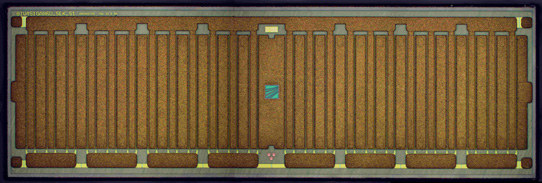News: Microelectronics
24 March 2020
Fraunhofer IAF boosts GaN transistor efficiency to record 77.3% at 1-2GHz after doubling operating voltage to 100V
The Fraunhofer Institute for Applied Solid State Physics (IAF) in Freiburg, Germany has significantly increased the output power of its gallium nitride (GaN) based high-frequency transistors for the frequency range from 1-2GHz, doubling the operating voltage of the devices from 50V to 100V and achieving record power-added efficiency (PAE) of 77.3%. The technology allows the development of high-efficiency amplifiers with even higher power, as required for applications in plasma generation, industrial heating, communications and radar technologies, adds IAF.

Picture: A 100V GaN power transistor with an output power of 600W at a frequency of 1.0GHz. © Fraunhofer IAF
For use in high-power applications in the GHz range, the power density of transistors determines the size of amplifier modules and thus largely the system complexity – both of which are decisive for the manufacturing costs and the required use of resources.
There are several ways to increase transistor power density. Fraunhofer IAF chose the path of increasing the operating voltage: By scaling the transistor design vertically and laterally, the researchers succeeded, for the first time in Europe, in realizing high‑frequency transistors suitable for applications at an operating voltage of 100V. The GaN-based devices are characterized by significantly increased power density at frequencies in the GHz range.
Laboratory measurements show record efficiency
Performance in the 1–2GHz frequency range has already been demonstrated in the laboratory. Measurements showed a power density of more than 17W/mm and a power-added efficiency of 77.3% at a frequency of 1.0GHz (the highest PAE achieved for 100V operation in this frequency range ever reported). Tests have even shown that this technology delivers a power density in excess of 20W/mm at 125V. The results were presented for the first time in December at the International Electron Devices Meeting (IEDM 2019) in San Francisco (S. Krause, P. Brückner, M. Dammann and R. Quay, ‘High-Power-Density AlGaN/GaN Technology for 100-V Operation at L-Band Frequencies’, 2019 IEDM, p17.4.1-17.4.4).
Twice the voltage for much higher power
“Increasing the operating voltage from 50V to 100V enables higher power densities. This means that a system can deliver more power on the same area than what is possible with commercially available 50V or 65V technologies,” says Sebastian Krause, one of the main developers of the technology.
On the one hand, this enables systems of the same size with higher output power. On the other hand, it is possible to create more compact and lighter systems delivering the same power, since less chip area is required to achieve the desired power level. “By doubling the operating voltage to 100V, the transistor exhibits a four times higher output impedance for a given power,” says Krause. This allows the implementation of smaller and therefore less lossy matching networks, which in turn results in higher energy efficiency of the overall system.
Usage in industrial high-power systems
“The long-term goal of our development is operation through 10GHz,” says Krause. This would make the Freiburg-based Fraunhofer Institute the first source for such 100V GaN‑based devices. This is of particular interest for high-performance applications such as particle accelerators, industrial microwave heaters, mobile-phone amplifiers, pulse- and continuous-wave radar and amplifiers for plasma generators. These systems require high output power levels while maintaining a preferably small footprint – exactly what the 100V technology can deliver, says IAF.
Particle accelerators play an important role in research, medical technology and industry. Plasma generators in the high-frequency range are used, for example, for coating processes in the production of semiconductor-based chips, data-storage media or solar cells.
Power semiconductors replace vacuum components
Another large industrial field of application is power generators for microwave heating. “In this field, industry usually works at higher frequencies, but vacuum components, e.g. magnetrons or klystrons, are predominantly used to date,” says Krause. “Here, we are working on providing a semiconductor-based alternative,” he adds. “Semiconductors are much more compact and more lightweight, which enables arrangements such as phased arrays.”
For many years, tube-based components (e.g. traveling-wave tubes) have dominated electronic systems with high output power. However, development is moving towards power semiconductors. Fraunhofer IAF believes that the GaN-based 100V technology can provide an efficient alternative for increasing the power of microwave generators.









